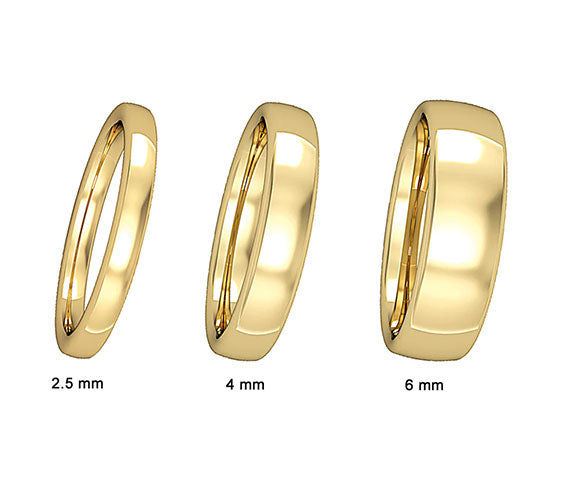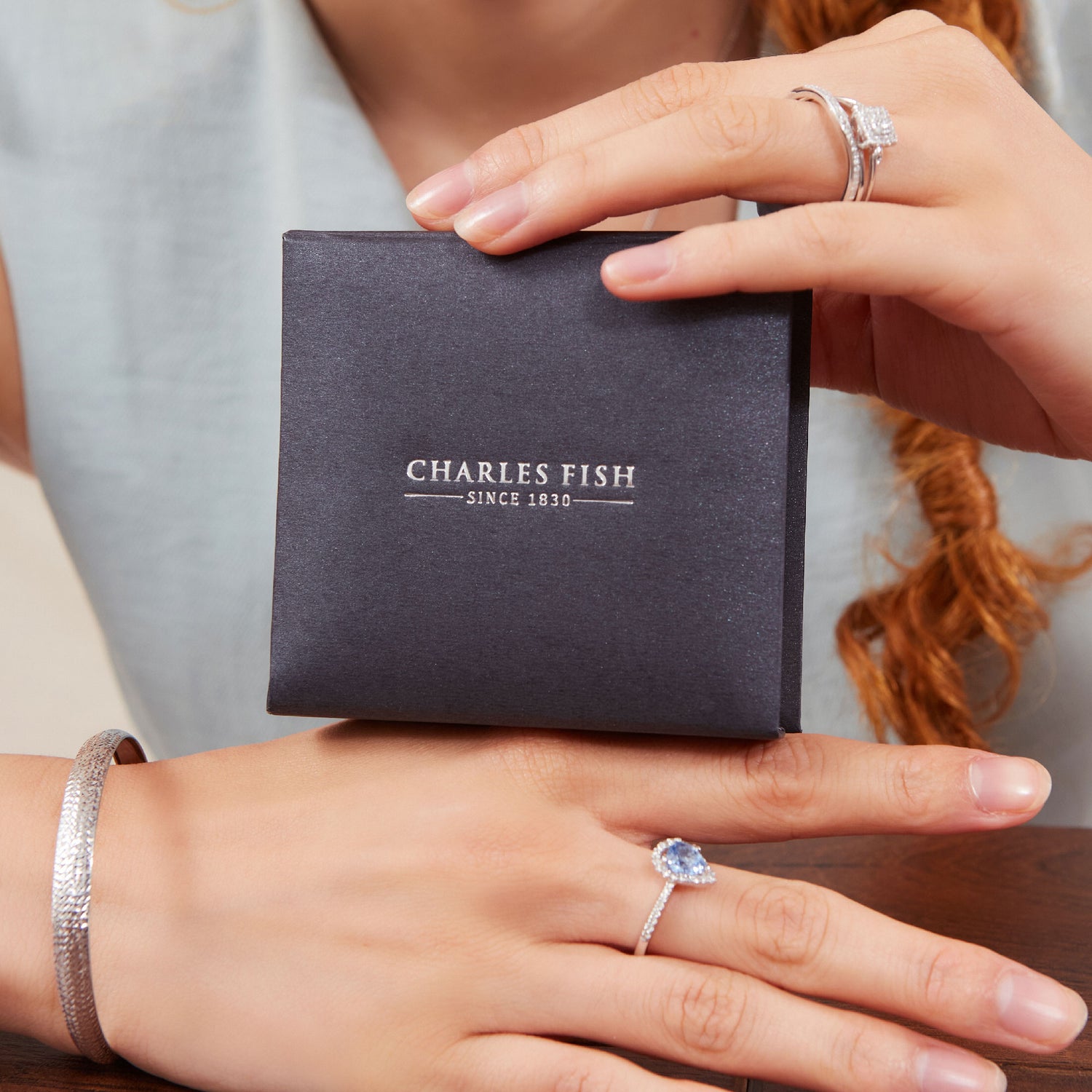Your complete guide to buying wedding rings
You’ve got the venue, the food, the music, the photographer, the dress, the suit – now all that’s left is to choose your wedding rings.
With its origins tracing back to Ancient Egypt, the tradition of exchanging wedding bands has endured for thousands of years. Even as styles have changed and tastes have modernised, the wedding band has remained a constant symbol of everlasting love. All you need to do is find the right one.
From traditional gold to exquisite platinum, from simple and understated to eye-catching diamonds, wedding rings can come in all sorts of different styles, shapes, widths and sizes. To help you find the perfect rings for your big day, we’ve put together this handy guide with everything you need to know about selecting your style, metal, size and finish. Whether you’re a traditionalist or you’re looking for something bohemian, we’ve got everything you need to choose a ring that will last a lifetime.
Choose your ring profile
A ring’s profile refers to the shape of the metal band. When choosing your wedding rings, one of the first things to think about is the kind of profile you’d like.
Here’s a full list of our wedding band profiles, including heavier premium styles for a little added luxury.
-

Court
Court-shaped rings are the most popular style of wedding bands – and one of the most comfortable. The band is straight all the way around the top and bottom and is softly rounded on both the inside and the outside of the ring. Regardless of the width, this classically rounded shape creates a seamless, comfortable fit.
-

Light Court
A more delicate, lightweight version of our classic court wedding rings.
-

Premium Court
A heavier, more luxurious version of our court wedding rings.
-

Flat court
Loved by both brides and grooms, flat court rings blend the comfort of court-shaped bands with a minimalist, more contemporary style. Similarly to court rings, flat court bands feature a curved interior, making it comfortable to wear. However, unlike court bands, flat court rings have a flat exterior, creating a simple, gender-neutral tone.
-

Premium flat court
A heavier, more luxurious version of our flat court wedding rings.
-

Bombé
Taking its name from the French word for bomb, bombé rings are named for their bomb-like shape. With a distinctive, rounded profile, these vintage rings were incredibly popular in the 50s and 60s, and remain a favourite for those looking for something a little bit retro. Similarly to court rings, they’re rounded interior also makes them incredibly comfortable.
-

Bombé Premium
A heavier, more luxurious version of our bombé wedding rings.
-

D-shape
Similarly to court rings, D-shaped wedding rings are straight all the way around the top and bottom, with a soft, curved finish. However, unlike court rings, D-shaped rings have a flat interior, creating a D-shape when the band is cross-sectioned. While more traditional in their style, D-shaped wedding rings aren’t as comfortable as court rings.
Choose your metal
One of the most important decisions facing wedding ring shoppers is which precious metal you’d like to adorn your finger. For centuries, yellow gold and white gold were the most popular options, but recent years have seen trends shift to include other metals, such as rose gold and platinum. If you wear one, it’s important to think about which metal will best complement your engagement ring. To preserve the quality of your wedding and engagement rings, you’ll also need to make sure they’re the same grade of metal.
To make things easier for you, we’ve laid out the different types of metal available for our wedding rings, including details about their colour, pricing and maintenance.
Yellow gold
Timeless and traditional, yellow gold is one of the most popular styles of wedding bands. With a warm golden glow, this highly polished style has a bright, fashionable finish. Our yellow gold wedding rings are available in both affordable 9ct gold and luxurious 18ct gold.
As well as having a classic look, yellow gold wedding bands are also straightforward to get sized and incredibly easy to look after. As time goes by, they can be professionally cleaned and polished to keep them looking as good as new.
White gold
A classic choice with a bright finish. Available in both 9ct and 18ct gold, white gold wedding rings are made from mixing yellow gold with a white metal alloy, such as silver or platinum. The ring is then coated in rhodium for a bright white lustre.
White gold rings tend to lose their shine over time, so they require a bit of maintenance. A fresh coat of rhodium every so often will keep your ring shining beautifully.
Rose gold
With their romantic hue and blushing finish, rose gold wedding rings are becoming increasingly popular. Rose gold is crafted from a blend of yellow gold and copper, creating a delicate, rosy-pink colour.
Platinum
Platinum is an extremely rare metal, making it an enviably luxurious choice for wedding rings. With a natural, bright-white colour, platinum creates a timeless finish for any wedding band.
Thirty times rarer than gold, platinum’s scarcity makes it one of the most expensive precious metals available. However, it’s also incredibly durable and hardwearing, with a naturally bright finish that won’t tarnish over time.
Palladium
Belonging to the same family as platinum, palladium is a lustrous white metal that’s perfect for wedding rings. Like platinum, it has a naturally bright white finish that won’t tarnish over time.
The main thing to think about when considering palladium for your wedding rings is the price. Although once half the price of platinum, the price of palladium has skyrocketed over the last few years, so it’s worth looking at the market before you make your decision.
Mix and match your metals
Can’t decide which metal to choose? Create something truly unique by mixing and matching your metals, with countless combinations available. Create a romantic two-tone effect with a white gold band and a rose gold centre, or mix warm yellow gold with a contrasting white gold centre – the options are endless.
Although exceptionally stylish, it’s important to remember that two-toned bands are trickier to refurb and size, so make sure to factor that into your decision.

Choose your band width
Another thing you’ll need to think about when choosing your wedding rings is the width of the bands. This is entirely down to personal preference, but most people tend to choose a size that suits their finger. If you have a slender finger, you might prefer a smaller band. If you have a broader finger, you might suit a larger size. It’s for this reason that men usually opt for larger rings.
Choose your finish
Your ring’s finish will determine whether you have an eye-catching shiny band or an understated, matte look.
At Charles Fish, we have two distinct finishes available:
-

Polished
A polished finish is the most common kind of finish for wedding rings. Shiny and reflective, this bright finish is perfect for anyone who wants an eye-catching wedding band.
-

Satin-brushed
A satin-brushed finish gives wedding bands a textured matte look, giving the appearance of brushstrokes in the metal. Its look is similar to a fogged-up mirror, offering a minimal, alternative vibe to traditional polished rings.
Before choosing a satin-brushed finish, it’s important to consider the maintenance required with this type of ring. Although it’s commonly assumed that brushed rings will hide scratches, they actually show marks more easily than polished rings. They also can’t be easily polished – to treat marked brushed rings, they need to be entirely refinished.
Make it your own
Simple and understated, or adorned with diamonds? Whatever your taste, there’s a wedding ring for you.
-

Eternity wedding rings
Add some sparkle to your wedding rings with a set of glittering diamonds, designed to represent the everlasting bond between you and your loved one. Known as eternity wedding rings, these bands feature a set of perfectly matched diamonds, encircling the ring continuously. You can choose between a half set of diamonds, covering half the ring, or a full set, depending on your taste.
-

Gemstones
If diamonds aren’t your thing, you can create an eternity-style ring with a different stone – whether that’s sapphire, aquamarine, ruby, emerald, or a combination of different stones. One popular option is to have a set of alternating sapphires and diamonds – the perfect match for a sapphire engagement ring.
Add an engraving
Usually requested for the inside of the ring, engravings give you the chance to personalise your wedding band with a message of love only your partner can see. Whether it’s a simple ‘I love you’, a nickname or a secret joke only the two of you will understand, engravings are the perfect way to create a ring that’s truly one of a kind.
Bespoke wedding rings at Charles Fish
At Charles Fish, we’re committed to helping you find the perfect ring. Whether it’s based on a picture you’ve found or something completely bespoke, we’ll work with you to create rings both you and your partner will love forever. And with over 190 years in the business, you can trust your rings are in good hands.
All our wedding rings are made to order and take between two and six weeks to make. With prices starting at £300, we can create wedding bands for every kind of budget. Prices vary depending on the size, style and metal of your ring, so our experts will give you advice to help you stay on budget.
Designing your dream ring
Whether you already have the perfect band in mind or you need a little help deciding, we’ll help you create the wedding ring of your dreams.
If you already have an idea of what you’re like, simply send us the details and we’ll give you a quotation.
If you need a little inspiration or you’d like to view some samples, you can pop into one of our stores or get in touch and book an appointment.
Our ring experts are on-hand to help you with whatever you need, whether that’s creating a wedding band to match an engagement ring or deciding which metals to choose.
Simply get in touch or pop into one of our stores, and we’ll be more than happy to help.
Flexible payment options
We know how expensive wedding days can be. That’s why we offer flexible payment options, giving you one less thing to worry about as you get ready for the big day. You can either pay a 50% deposit upfront and the rest on delivery, or pay a smaller deposit (a choice of 10% to 50%) and pay the rest off in monthly, interest-free instalments. The choice is yours!
Get in touch today
To find out more about our bespoke wedding rings, or to book an appointment in store
Get in touch with us – we’d love to hear from you! Alternatively, you can pop in-store and speak to one of our advisors.
{formbuilder:MTIwMDQw}
















